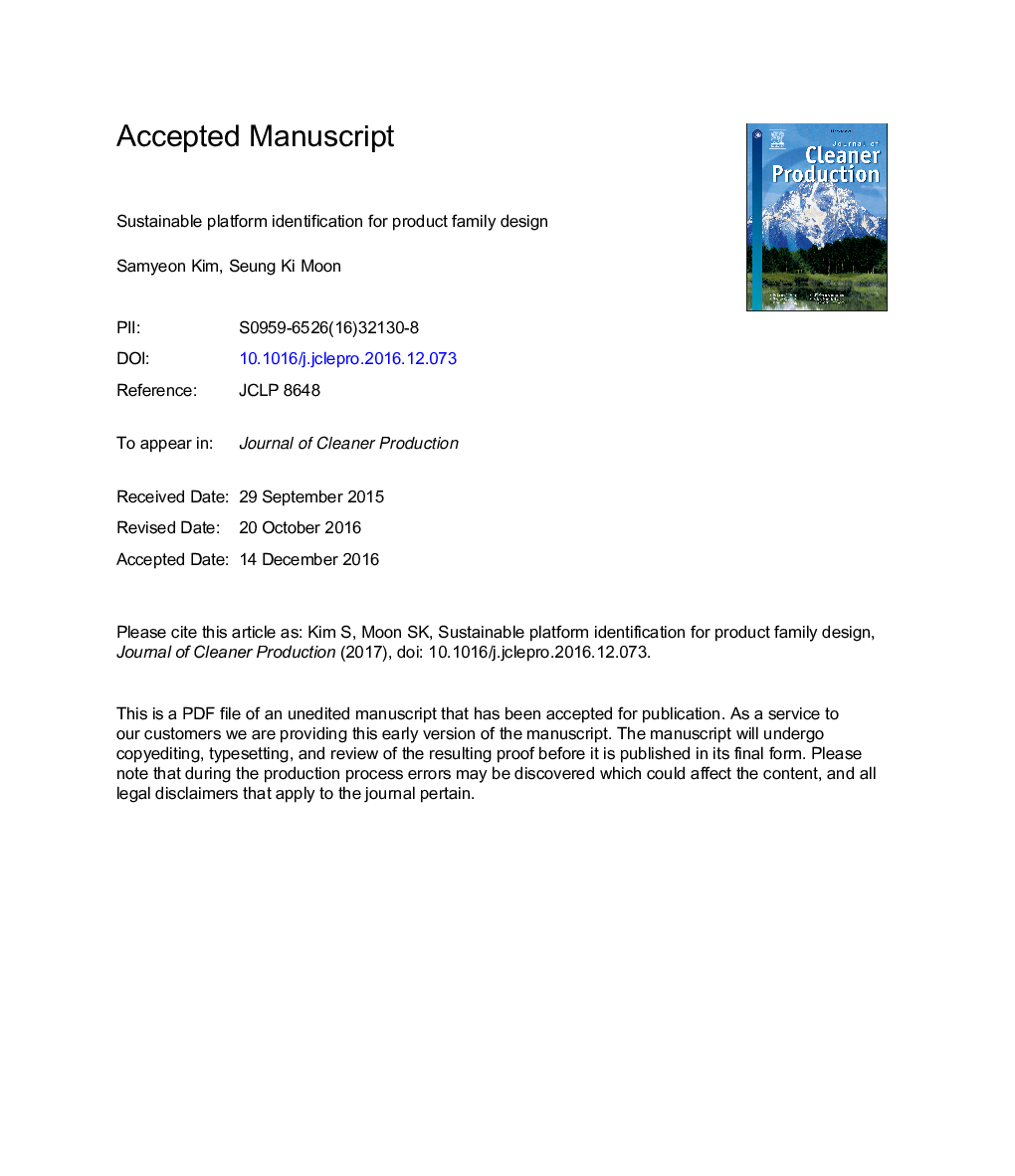| کد مقاله | کد نشریه | سال انتشار | مقاله انگلیسی | نسخه تمام متن |
|---|---|---|---|---|
| 5481106 | 1522110 | 2017 | 51 صفحه PDF | دانلود رایگان |
عنوان انگلیسی مقاله ISI
Sustainable platform identification for product family design
ترجمه فارسی عنوان
شناسایی پلت فرم پایدار برای طراحی محصول خانواده
دانلود مقاله + سفارش ترجمه
دانلود مقاله ISI انگلیسی
رایگان برای ایرانیان
کلمات کلیدی
شبکه بیزی، تغییر انتشار، تجزیه و تحلیل رابطه ای خاکستری طراحی خانواده ارزیابی پایداری، پلت فرم پایدار،
ترجمه چکیده
با رقابت جهانی بازار، طراحی محصول خانواده و یک استراتژی مبتنی بر پلت فرم توجه زیادی را برای ارائه محصولات متنوعی از محصولات به شیوه ای اقتصادی به دست آورده اند. بیشترین تحقیق قبلی برای طراحی محصول خانواده بر مزایای اقتصادی خود از طریق به اشتراک گذاری پلت فرم مشترک برای مرحله تولید متمرکز شده است. از آنجایی که آگاهی از نگرانی های زیست محیطی در حال افزایش است، مقررات زیست محیطی سخت تر می شوند، که به نوبه خود طراحان را مجبور می کند تا ویژگی های اضافی در طراحی خانواده را در نظر بگیرند، مثلا پایداری. به منظور در نظر گرفتن پایداری در طراحی خانواده خانواده، استراتژی پلت فرم برای تولید باید از دیدگاه پایداری دوباره طراحی و تفسیر شود زیرا این پلتفرم با تمام محصولات در خانواده محصول به اشتراک گذاشته شده است. در این تحقیق یک روش جدید برای شناسایی یک سکوی پایدار برای یک خانواده محصول پیشنهاد شده است. پلت فرم پایدار دارای سه ویژگی است: پایداری بالا، ریسک کمتری در طراحی مجدد محصول و همبستگی بالا. برای میزان پایداری، شاخص های پایداری مانند شاخص های زیست محیطی، اقتصادی و اجتماعی به یک ارزش پایدار یک محصول با استفاده از رویکرد تصمیم گیری چند ویژگی جمع می شوند. به منظور تجزیه و تحلیل ریسک به طراحی مجدد محصول، یک مدل خطر برای پیش بینی تغییرات غیرمنتظره اجزای سیستم یا زیر سیستم ها و همچنین انتشار تغییرات آن بر اساس شبکه بیزی ارائه شده است. به عنوان ویژگی اصلی طراحی پلت فرم فعلی مشترک است، میزان همبستگی نیز در طول خانواده تجزیه و تحلیل شده است. سیستم استنتاج فازی برای ارزیابی و انتخاب پلت فرم پایدار بر اساس سه ویژگی استفاده می شود. برای نشان دادن اثربخشی روش پیشنهادی، یک مطالعه موردی با یک خانواده از سازندگان قهوه انجام می شود. در نتیجه، روش پیشنهادی در شناسایی یک پلت فرم محصول از منظر پایداری با پیوند پایداری با طراحی محصول موثر است.
موضوعات مرتبط
مهندسی و علوم پایه
مهندسی انرژی
انرژی های تجدید پذیر، توسعه پایدار و محیط زیست
چکیده انگلیسی
With global market competition, product family design and a platform-based strategy have received a lot of attention for providing sufficient variety of products in an economical way. Most previous research for the product family design has focused on its economic benefits by sharing common platform for manufacturing phase. Since awareness of environmental concerns is growing at an ever-increasing rate, environmental regulations are becoming more stringent, which in turn pushes designers to consider extra features in product family design, for example, sustainability. In order to consider the sustainability in the product family design, the platform strategy for manufacturing should be redesigned and reinterpreted from the viewpoint of the sustainability because the platform is shared with all products in the product family. In this research, a novel methodology is proposed to identify a sustainable platform for a product family. The sustainable platform has three characteristics: high sustainability, low risk to product redesign, and high commonality. For degree of sustainability, the values of sustainability indicators such as environmental, economic, and social indicators are aggregated to a single sustainability value of a product using a multi-attribute decision making approach. In order to analyze the risk to product redesign, a model of the risk is introduced to predict the unexpected changes of components or sub-systems, as well as its change propagations based on Bayesian network. As main characteristic of current platform design is commonality, the degree of the commonality is also analyzed along the product family. A fuzzy inference system is utilized to assess and select the sustainable platform based on the three characteristics. To demonstrate the effectiveness of the proposed methodology, a case study is carried out with a family of coffee makers. Consequently, the proposed methodology contributes to identifying a product platform from the viewpoint of sustainability by linking the sustainability to product design.
ناشر
Database: Elsevier - ScienceDirect (ساینس دایرکت)
Journal: Journal of Cleaner Production - Volume 143, 1 February 2017, Pages 567-581
Journal: Journal of Cleaner Production - Volume 143, 1 February 2017, Pages 567-581
نویسندگان
Samyeon Kim, Seung Ki Moon,
